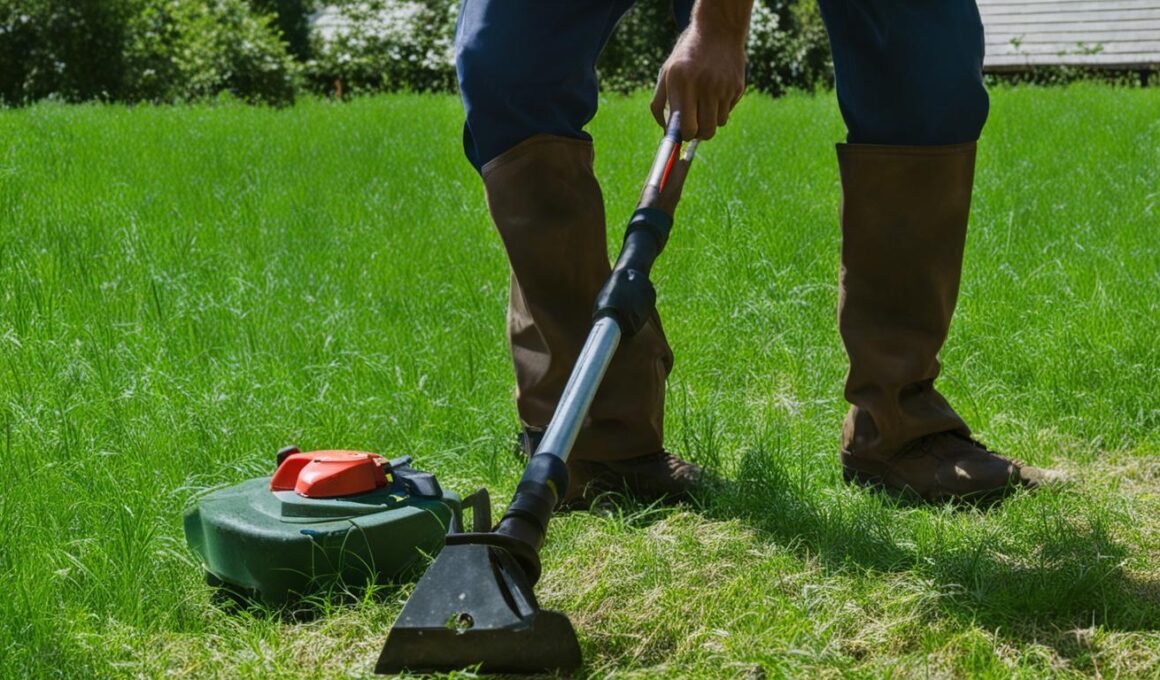Welcome to our comprehensive guide on mastering weed eaters and learning how to use them effectively for your yard maintenance needs. Whether you’re a seasoned gardener or a beginner looking to keep your lawn in top shape, understanding the proper usage of a weed eater is essential for achieving professional-looking results.
Using a weed eater may seem daunting at first, but with the right safety precautions and technique, you’ll soon become a pro. In this article, we’ll cover everything you need to know about using a weed eater, from safety tips to choosing the right tool for your specific needs. Let’s dive in and transform your yard maintenance routine!
Key Takeaways:
- Wear eye protection to shield against debris while using a weed eater.
- Regularly check the condition of the string and replace it if frayed or damaged.
- Properly hold the weed eater with the right hand on the front handle and the left hand on the rear handle for better control.
- Start with the lowest setting and focus on trimming the lawn edges before moving on to other areas of the yard.
- Choosing the right weed eater based on your needs and preferences is crucial for optimal performance.
Essential Safety Tips for Using a Weed Eater
When it comes to using a weed eater, safety should always be your top priority. By following these essential safety tips, you can ensure a safer and more productive yard maintenance experience.
-
Wear Eye Protection: Always wear proper eye protection, such as safety glasses or goggles, to shield your eyes from debris that may be kicked up while using the weed eater. Flying rocks, wood chips, and grass clippings can cause serious eye injuries if not protected against.
-
Check String Condition: Before starting your weed eater, make it a habit to inspect the condition of the string. If you notice any fraying or damage, it’s crucial to replace it promptly. Using a damaged string can lead to reduced efficiency and increase the risk of accidents.
-
Hold the Weed Eater Correctly: Properly gripping the weed eater improves control and overall safety. Hold the device with both hands, with your right hand on the front handle and your left hand on the rear handle. This grip allows for better maneuverability and reduces the chances of losing control.
-
Start with the Lowest Setting: When operating the weed eater, it’s recommended to start with the lowest setting. This allows for a steady trimming process and helps you familiarize yourself with the device’s operation. Once you feel comfortable, you can gradually increase the speed or switch to a higher setting based on your needs.
-
Focus on Lawn Edges: To gain confidence and refine your technique, focus on trimming the lawn edges first. This area requires precision and attention to detail. By starting here, you can practice controlled movements and get accustomed to the feel and balance of the weed eater.
Remember, a properly maintained weed eater and adherence to safety precautions can make a significant difference in preventing accidents and injuries during yard maintenance.
Proper Technique for Using a Weed Eater
Mastering the proper technique for using a weed eater is crucial to ensuring efficient and effective yard maintenance. By following these guidelines, you can achieve precise cuts and maintain the edges of your lawn with ease.
Hold the Tool Vertically
When operating a weed eater, it’s important to hold the tool vertically. This allows for better control and maneuverability while trimming the grass. Keep a firm grip on the handle and maintain a steady pace as you walk forward.
Pay Attention to Obstacles
As you work, pay close attention to any obstacles in your path, such as rocks, tree roots, or garden structures. Adjust the height setting of the weed eater as needed to avoid damaging these objects. By staying vigilant and making the necessary adjustments, you can prevent accidents and maintain a pristine yard.
Start with Lawn Edges
When beginning your weed eating session, it’s recommended to start with the lawn edges. This is because the edges require precision and attention to detail. By focusing on the edges first, you can ensure a clean and polished look to your lawn.
Gradually Move to Other Areas
Once you have mastered trimming the lawn edges, you can gradually move on to other areas of your yard. Whether it’s tackling rough patches of overgrown grass or reaching tight corners, applying the proper technique will allow you to maintain a uniform and well-groomed outdoor space.
Remember, practice makes perfect when it comes to using a weed eater. With time and experience, you’ll become more comfortable with the tool and develop your own techniques. Just ensure that you always prioritize safety and take the necessary precautions to prevent any accidents or injuries.
Choosing the Right Weed Eater for Your Needs
When it comes to selecting a weed eater, it’s essential to consider your specific needs and preferences. By choosing the right tool for the job, you can ensure efficient and effective yard maintenance.
If you have a larger property or often tackle heavy-duty tasks, a gas-engine string trimmer might be the best option. Gas-powered weed eaters offer more power, allowing you to trim through tough vegetation with ease. They are also suitable for extended periods of use without the need for recharging or battery replacements.
On the other hand, if you have a smaller yard or prioritize noise reduction, a battery-powered trimmer is worth considering. These weed eaters are quieter and more convenient, as they do not require gas or oil. Battery-powered trimmers are also generally lighter in weight, making them easier to maneuver and operate for longer periods.
When making your decision, it’s important to assess various factors such as weight, voltage, and battery capacity. These factors will directly impact the usability and performance of the weed eater. Aim to find the right balance between power and convenience, ensuring the weed eater matches the level of work you intend to do.
Remember, a well-informed choice in selecting a weed eater will contribute to a smoother and more enjoyable yard maintenance experience.
Conclusion
Mastering the use of a weed eater requires attention to safety, proper technique, and selecting the right tool for the job. By wearing eye protection, checking the string condition, and holding the weed eater correctly, you can ensure your safety while working.
Starting with the lawn edges and gradually progressing to other areas of the yard allows for a systematic approach to yard maintenance. This enables you to trim and tidy your lawn effectively. Remember to maintain a steady pace, pay attention to obstacles, and adjust the height setting as needed to achieve precise and clean results.
Choosing the right weed eater based on your needs is crucial for a successful yard maintenance routine. Consider factors such as the size of your yard, the level of work you intend to do, and your preferred power source. Whether you opt for a gas-engine string trimmer or a battery-powered trimmer, make sure it aligns with your requirements and provides the necessary power and efficiency.
Is Using a Pre-Emergent Herbicide Necessary When Using a Weed Eater?
When using a weed eater, using a pre-emergent herbicide is necessary for effective weed control. Proper herbicide selection for weed control can prevent the growth of unwanted plants and minimize the need for frequent maintenance. It is an essential step in maintaining a healthy and tidy outdoor space.
FAQ
What safety precautions should I take when using a weed eater?
Always wear eye protection to shield against flying debris. Check the condition of the string and replace if necessary.
How should I hold a weed eater for optimal control?
Hold the weed eater with your right hand on the front handle and your left hand on the rear handle.
Is there a specific technique for using a weed eater?
Hold the weed eater vertically and walk forward at a steady pace. Start with the lowest setting and focus on trimming lawn edges before moving on to other areas.
How do I choose the right weed eater for my needs?
Consider factors such as power source, weight, and capacity. Gas-engine trimmers offer more power for larger properties, while battery-powered trimmers are convenient for smaller yards.










